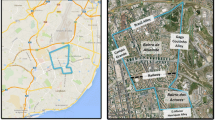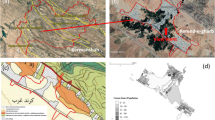Abstract
This work approaches the seismic vulnerability assessment of an old stone masonry building aggregate, located in San Pio delle Camere (Abruzzo, Italy), slightly affected by the 2009 April 6th earthquake occurred in L’Aquila and its districts. This building aggregate has been modelled by using the 3muri® software for seismic analysis of masonry constructions. On one hand, static non-linear numerical analyses were performed to obtain capacity curves together with the prediction of damage distributions for the input seismic action (hybrid technique). On the other hand, indirect techniques, based on different vulnerability index formulations, were used for assessing the building aggregate’s behaviour under earthquake action. The activities carried out have provided a clear framework on the seismic vulnerability of building aggregates, as well as aid future retrofitting interventions.












Similar content being viewed by others
References
Ademović N, Oliveira DV (2012) Seismic assessment of a typical masonry residential building in Bosnia Herzegovina. In: Proceeding of the 15th world conference of earthquake engineering—WCEE, Lisbon, Portugal
Benedetti D, Petrini V (1984) Sulla Vulnerabilità Sismica degli Edifici in Muratura: proposta di un Metodo di Valutazione. L’industria Italiana delle Costruzioni 149(1):66–74 (In Italian)
Bernardini A, Giovinazzi S, Lagomarsino S, Parodi S (2007) Vulnerabilità e previsione di Danno a Scala Territoriale secondo una metodologia Macrosismica coerente con la Scala EMS-98. In: Proceedings of the 12th Italian conference on earthquake engineering, 10–14 June, Pisa, Italy (in Italian)
Binda L, Baronio G, Cardani G, Penazzi D, Tedeschi C, Tongini FR (2001) Il Progetto di Conservazione, 174–197. S. Pesenti, Alinea (in Italian)
Calvi GM, Pinho R, Magenes G, Bommer JJ, Restrepo-Vélez LF, Crowley H (2006) Development of seismic vulnerability assessment methodologies over the past 30 years. ISET J Earthq Technol 472(43):75–104
Candela M, Cattari S, Lagomarsino S, Fonti R, Pagliuca E (2011) Prove in situ per la Valutazione della Risposta nel Piano di un Pannello Murario in un Edificio a L’Aquila. In: Proceedings of the 14th Italian conference on earthquake engineering—ANIDIS. Italian National Association of Earthquake Engineering, Bari, Italy (in Italian)
Carocci CF, (2001) Guidelines for the safety and preservation of historical centres in seismic areas. In: Historical constructions, Guimarães, Portugal, pp 145–166
Chever L (2012) Use of seismic assessment methods for planning vulnerability reduction of existing building stock. In: Proceedings of the 15th world conference on earthquake engineering—WCEE, Lisbon, Portugal
Chopra AK, Goel RK (1999) Capacity-demand-diagram methods based on inelastic design spectrum. Earthq Spectra 15:637–656. doi:10.1193/1.1586065
DM (2008) Decreto Ministeriale 14/01/2008. Nuove Norme tecniche delle Costruzioni (in Italian)
Erdik M (2007) Earthquake disaster scenario prediction and loss modelling for urban areas. Lessloss report. Risk mitigation for earthquakes and landslides. IUSS Press, Pavia
FEMA (2003) Multi-hazard loss estimation methodology: earthquake model. Department of Homeland Security, FEMA, Washington, DC, Technical report
Ferreira TM, Vicente R, Varum H (2012) Vulnerability assessment of building aggregates: a macroseimic approach. In: Proceedings of the 15th world conference on earthquake engineering—WCEE, Lisbon, Portugal
Ferreira TM, Vicente R, Mendes da Silva JAR, Varum H, Costa A (2013) Seismic vulnerability assessment of historical urban centres: case study of the old city centre in Seixal, Portugal. Bull Earthq Eng 11:1753–1773. doi:10.1007/s10518-013-9447-2
Fonti R, Formisano A, Mazzolani FM (2013) Le strutture ad arco negli aggregati su pendio: un caso studio nel centro storico di San Pio delle Camere (AQ). In: Proceedings of the 15th Italian conference on earthquake engineering, Padova University Press, Padova, Italy (in Italian)
Formisano A (2012) Seismic behaviour and retrofitting of the Poggio Picenze Historical Centre damaged by the L’Aquila earthquake. In: Topping BHV, (ed) Proceedings of the eleventh international conference on computational structures technology, Civil-Comp Press, Stirlingshire, UK, Paper 199. doi:10.4203/ccp.99.199
Formisano A, Di Feo P, Grippa, MR, Florio G (2010a) L’Aquila earthquake: a survey in the historical centre of Castelvecchio Subequo. In: Proceedings of the COST action C26 final conference “urban habitat constructions under catastrophic events”. Federico M. Mazzolani, Chair, Naples, 16–18 September 2010, CRC Press, Taylor & Francis Group, London, pp 371–376, ISBN: 978-0-415-60685-1
Formisano A, Mazzolani FM, Florio G, Landolfo R (2010b) A Quick Methodology for seismic vulnerability assessment of historical masonry aggregates. In: Proceedings of the COST action C26 final conference “urban habitat constructions under catastrophic events”, Federico M. Mazzolani, Chair, Naples, 16–18 September 2010, CRC Press, Taylor & Francis Group, London, pp 577–582, ISBN: 978-0-415-60685-1
Formisano A, Florio G, Landolfo R, Mazzolani FM (2011) Numerical calibration of a simplified procedure for the seismic behaviour assessment of masonry building aggregates. In: Topping BHV, Tsompanakis Y (ed) Proceedings of the thirteenth international conference on civil, structural and environmental engineering computing, Civil-Comp Press, Stirlingshire, UK, Paper 172. doi:10.4203/ccp.96.172
Formisano A, Castaldo C, Mazzolani FM (2013) Non-linear analysis of masonry building compounds: a comparison of numerical and theoretical results. In: Topping BHV, Iványi P (eds) Proceedings of the fourteenth international conference on civil, structural and environmental engineering computing, Civil-Comp Press, Stirlingshire, UK, Paper 66. doi:10.4203/ccp.102.66
Freeman SA (1998) Development and use of capacity spectrum method. In: Proceedings of the 6th US NCEE conference on earthquake engineering, Seattle, Washington DC, USA
Giovinazzi S (2005) The vulnerability assessment and damage scenario in seismic risk analysis, PhD Thesis, University of Florence, Florence, Italy
Giovinazzi S, Lagomarsino S (2006) Damage assessment of current buildings at territorial scale: a mechanical model calibrated on a macroseismic vulnerability model. Genoa, Italy
GNDT-SSN (1994) Scheda di esposizione e vulnerabilità e di rilevamento danni di primo livello e secondo livello (muratura e cemento armato). Grupo Nazionale per la Difesa dai Terrmoti, Rome, Italy (in Italian)
Grünthal G (1998) European Macroseismic Scale 1998 (EMS-98), European Seismological Commission, Subcommission on Engineering Seismology, Working Group Macroseismic Scales 15:101
Guagenti E, Petrini V (1989) Il caso delle Vecchie Costruzioni: verso una nuova legge danni-intensità. In: Proceedings of the 12th Italian conference on earthquake engineering—ANIDIS. Italian National Association of Earthquake Engineering, Pisa, Italy (in Italian)
Indirli MS, Kouris LA, Formisano A, Borg RP, Mazzolani FM (2013) Seismic damage assessment of unreinforced masonry structures after the Abruzzo 2009 earthquake: the case study of the historical centers of L’Aquila and Castelvecchio. Int J Archit Herit 7:536–578. doi:10.1080/15583058.2011.654050
Lagomarsino S, Giovinazzi S (2006) Macroseismic and mechanical models for the vulnerability and damage assessment of current buildings. Bull Earthq Eng 4:415–443
Maio R (2013) Seismic vulnerability assessment of old stone masonry building aggregates. MSc Thesis, Civil Engineering Department of the University of Aveiro, Aveiro, Portugal
Mannari A, Scaramuzzino L, Stefanelli S et al (2011) Studi E Indagini Sul Rischio Sismico Del Centro Storico Di San Pio Delle Camere (AQ). Studi e Indagini sul Rischio Sismico del Centro Storico di San Pio delle Camere, 8800381:245 (in Italian)
Margottini C, Molin D, Narcisi B, Serva L (1992) Intensity versus ground motion: a new approach using Italian data. Eng Geol 33(1):45–58, ISSN 0013-7952. doi:10.1016/0013-7952(92)90034-V
Marques R, Vasconcelos G, Lourenço PB (2012) Pushover analysis of a modern aggregate of masonry building through macro-element modelling. In: Proceedings of the 15th international brick and block masonry conference, Florianopolis, Brazil
Mouroux P, Le Brun B (2006) Presentation of RISK-UE project. Bull Earthq Eng 4:323–339. doi:10.1007/s10518-006-9020-3
Murphy JR, O’Brien LJ (1977) The correlation of peak ground acceleration amplitude with seismic intensity and other physical parameters. Bull Seismol Soc Am 67(3):877–915
ReLUIS (2010) Linee Guida per il rilievo, l’analisi ed il progetto di interventi di riparazione e consolidamento sismico di edifici in muratura in aggregato, (draft version n.3). Developed by a joint working group: ReLUIS, Dipartimento Protezione Civile, Ufficio del Vice-Commissario Delegato per la Messa in Sicurezza dei Beni Culturali and Struttura Tecnica di Missione (in Italian)
Salamon A, Amit R, Baer G et al. (2010) The Mw 6.3, 2009 L’Aquila earthquake, Central Italy: report of the GSI team visit to the affected area. Technical report, Jerusalem, Israel
Scheda di Aggregato (2010) Scheda di Aggregato No.8800378 of San Pio delle Camere, Italy. Technical report, University of Pisa, Pisa, Italy (in Italian)
Spence R, Bommer J, Re DDEL (2003) Comparing loss estimation with observed damage: a study of the 1999 Kocaeli Earthquake in Turkey. Bull Earthq Eng 1:83–113
Vicente R (2008) Estratégias e Metodologias para Intervenções de Reabilitação Urbana—Avaliação da Vulnerabilidade e do Risco Sísmico do Edificado da Baixa de Coimbra. PhD Thesis, Civil Engineering Department of the University of Aveiro, Aveiro, Portugal (in Portuguese)
Acknowledgments
The authors would like to acknowledge to Eng. Davide Seni of the S.T.A. DATA company for giving the license to work with 3muri® and Dr. Serena Cattari for the useful suggestions on the use of the program. Lastly, a sincere acknowledge to Prof. Mauro Sassu, who provided drawings and information on the case study.
Author information
Authors and Affiliations
Corresponding author
Rights and permissions
About this article
Cite this article
Maio, R., Vicente, R., Formisano, A. et al. Seismic vulnerability of building aggregates through hybrid and indirect assessment techniques. Bull Earthquake Eng 13, 2995–3014 (2015). https://doi.org/10.1007/s10518-015-9747-9
Received:
Accepted:
Published:
Issue Date:
DOI: https://doi.org/10.1007/s10518-015-9747-9




